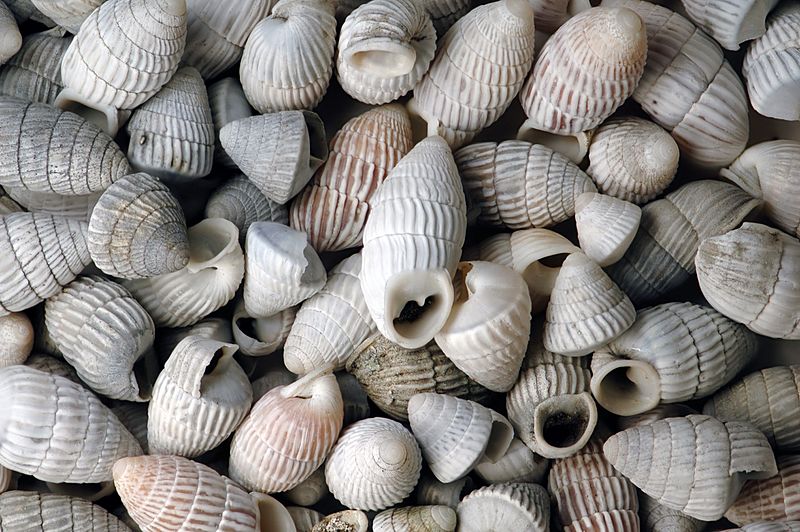Image: Cerion watlingense land snail shells (modern; northeastern San Salvador Island, eastern Bahamas) (15043406837)

Description: Cerion watlingense Dall, 1907 - modern shells; large white shell at center is 22 mm tall.
A distinctive land snail found throughout much of the Caribbean is Cerion. The genus name comes from the Latin “ceri-“ meaning “wax”, in reference to the beehive shape of shells in mid-ontogeny. Many individual species occur on only one island (if taxonomic splitters are correct in species identifications). Cerion watlingense is restricted to San Salvador Island (formerly Watling’s Island) in the eastern Bahamas. It is abundant throughout the island. The shells here are modern shells, but fossil shells of Cerion watlingense also occur in the island’s Pleistocene and Holocene bedrock & paleosols.
San Salvador has one other nominal species - Cerion rodrigoi, but that has a distribution restricted to parts of the island’s eastern coast. Extensive hybridization has occurred between C. watlingense and C. rodrigoi, resulting in intermediate morphologies. Some researchers suggest that recognizing two separate Cerion species on San Salvador may not be warranted. Taxonomic lumpers assign San Salvador Island’s forms to Cerion glans.
Cerion watlingense is a true land snail and living specimens can be found attached to vegetation or rock surfaces. Dead & empty shells are found all over San Salvador Island - inland, near the coasts, along the shores of ponds and lakes, and on marine beaches. Empty shells are sometimes occupied by terrestrial hermit crabs and even marine hermit crabs.
Classification: Animalia, Mollusca, Gastropoda, Pulmonata, Stylommatophora, Orthalicoidea, Cerionidae
The shells shown here are from the northeastern part of San Salvador Island, and range in color from whitish to grayish to mottled brownish. Most of the specimens are adults. Adult Cerion shells are those that have reached “phase 3” of their ontogeny (growth). Phase 3 shells have a thickened apertural lip. Once the thickened lip is constructed, the shell does not enlarge further. Thickened apertural lips are a consistent characteristic in adult land snails.
Mostly synthesized from info. in:
Gould (1984) - Paleobiology 10(2): 172-194.
Gould (1997) - Proceedings of the 8th Symposium on the Geology of the Bahamas and Other Carbonate Regions, May 30-June 3, 1996: 73-91.
Fronabarger et al. (1997) - Proceedings of the 8th Symposium on the Geology of the Bahamas and Other Carbonate Regions, May 30-June 3, 1996: 59-72.
Baldini et al. (2007) - Palaios 22(2): 174-187.
Author: James St. John
Usage Terms: Creative Commons Attribution-Share Alike 3.0
License: CC-BY-SA-3.0
License Link: http://creativecommons.org/licenses/by-sa/3.0/
Attribution Required?: Yes
Image usage
The following page links to this image:

